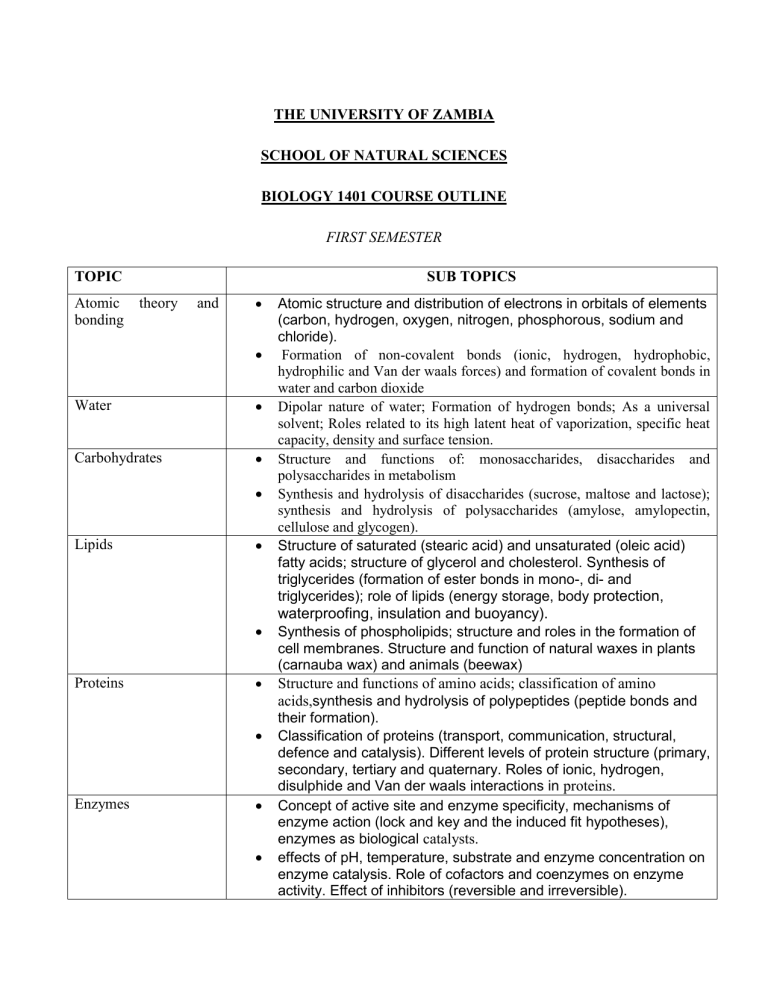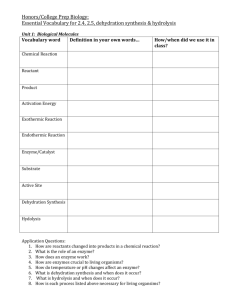
THE UNIVERSITY OF ZAMBIA SCHOOL OF NATURAL SCIENCES BIOLOGY 1401 COURSE OUTLINE FIRST SEMESTER TOPIC Atomic bonding SUB TOPICS theory and Water Carbohydrates Lipids Proteins Enzymes Atomic structure and distribution of electrons in orbitals of elements (carbon, hydrogen, oxygen, nitrogen, phosphorous, sodium and chloride). Formation of non-covalent bonds (ionic, hydrogen, hydrophobic, hydrophilic and Van der waals forces) and formation of covalent bonds in water and carbon dioxide Dipolar nature of water; Formation of hydrogen bonds; As a universal solvent; Roles related to its high latent heat of vaporization, specific heat capacity, density and surface tension. Structure and functions of: monosaccharides, disaccharides and polysaccharides in metabolism Synthesis and hydrolysis of disaccharides (sucrose, maltose and lactose); synthesis and hydrolysis of polysaccharides (amylose, amylopectin, cellulose and glycogen). Structure of saturated (stearic acid) and unsaturated (oleic acid) fatty acids; structure of glycerol and cholesterol. Synthesis of triglycerides (formation of ester bonds in mono-, di- and triglycerides); role of lipids (energy storage, body protection, waterproofing, insulation and buoyancy). Synthesis of phospholipids; structure and roles in the formation of cell membranes. Structure and function of natural waxes in plants (carnauba wax) and animals (beewax) Structure and functions of amino acids; classification of amino acids,synthesis and hydrolysis of polypeptides (peptide bonds and their formation). Classification of proteins (transport, communication, structural, defence and catalysis). Different levels of protein structure (primary, secondary, tertiary and quaternary. Roles of ionic, hydrogen, disulphide and Van der waals interactions in proteins. Concept of active site and enzyme specificity, mechanisms of enzyme action (lock and key and the induced fit hypotheses), enzymes as biological catalysts. effects of pH, temperature, substrate and enzyme concentration on enzyme catalysis. Role of cofactors and coenzymes on enzyme activity. Effect of inhibitors (reversible and irreversible). Nucleic acids Synthesis of nucleotides (structure of pentose sugar, bases and phosphoric acid). Structure and functions of DNA and RNAs (mRNA, tRNA and rRNA). Synthesis of polynucleotides (DNA and RNA). Prokaryotes: Typical structure of bacterial cells (Escherichia coli); structure and functions of the cell wall, cell membrane (to include phospholipids, proteins, carbohydrates and chromosomal DNA and plasmids). Eukaryotes Structure of a typical plant cell (leaf palisade cell) and a typical animal cell (liver cell). Functions of the cell wall, cell membrane and organelles. REFERENCES KENT, M. (2000) : Advanced biology. Oxford university press, London. Elliet, W. H and Elliot . D,C. (2004). Biochemistry and molecular biology. 3 rd edition. University press, oxford. Taylor, D. J, Green, N. P.O and stout, G.w. (1997) biological sciences. Cambridge University press, London. Solomon, E. P and Berge, L.R (1994) : the world of biology. Sounders college publishing. 5th edition. Scott freeman (2008) : biological sciences, 3rd edition. Person International Edition.
